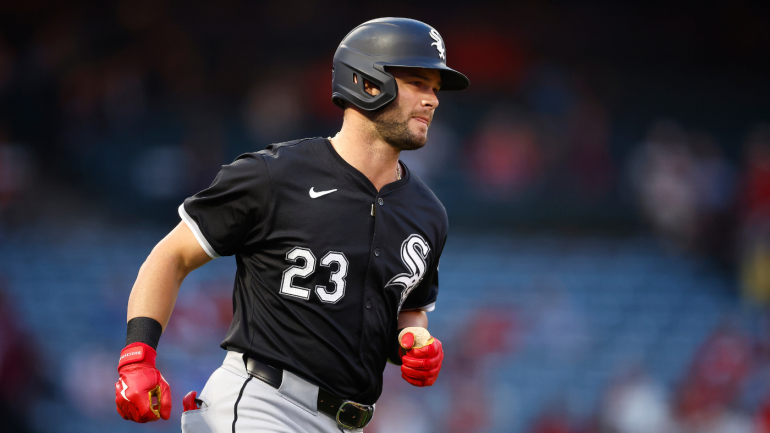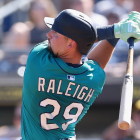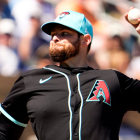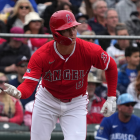
Less than two weeks remain in the 2024 MLB regular season and the various postseason races (and awards races) are really heating up. Everything will be decided by the end of the month. The marathon that is the regular season has become a sprint to the finish. With that in mind, here are three MLB trends worth knowing as we near the finish line.
Benintendi's bat finally waking up
You are forgiven if you have not paid much attention to the White Sox lately. Other than their march to the Modern Era loss record, there just isn't anything notable going on with the team. They're very bad, they play boring baseball, and I'm not sure a single player on the roster will still be around whenever they get back to the postseason. It's a sad state of affairs on the south side.
The silver lining these last few weeks: Andrew Benintendi. Last year, the White Sox gave Benintendi the richest contract in franchise history -- five years and $75 million -- and he rewarded them with a .262/.326/.356 batting line and 0.2 WAR. It quickly became one of the worst contracts in baseball. As recently as July 13, Benintendi was hitting .192/.248/.292. Against all odds, his 2024 was worse than his 2023.
Benintendi has been a much different hitter the last two months. Going into Tuesday night's game, Benintendi was hitting .279/.351/.552 with 13 home runs in his previous 53 games dating back to July 14. That includes a two-homer game Monday.
Benintendi has 13 home runs in his last 53 games after hitting 16 home runs in his previous 357 games dating back to 2021. He's never been much of a power hitter, but still, Benintendi hit five home runs in 2022 and again in 2023, and it's hard to be even an average corner outfielder with that little power, especially with his glove in decline (minus-11 defensive runs saved in 2024).
These days, almost every increase in power output is tied to pulling the ball more often, and that's exactly what has happened with Benintendi. For most of his career, he's been content to serve line drives the other way to left field, which worked especially well in Fenway Park during his time with the Red Sox. The last few years he took it to the extreme though, and his power vanished.
Through July 13, Benintendi was sporting a 40.1% pull rate and 29.2% hard-hit rate. The league averages for left-handed hitters are 40.4% and 38.6%, respectively. Since July 13, Benintendi has upped those numbers to a 53.8% pull rate and 42.8% hard-hit rate. It is a tale as old as time. Pull the ball and power production goes up. Benintendi hasn't sacrificed his batting average either.
What does Benintendi's power display mean for the White Sox? Not much on the field, though perhaps it makes him more tradeable in the offseason, not that he's especially valuable given his contract and poor defense. Given the investment, it's better to get something from Benintendi than nothing. If his power breakout carries over into 2025, then a trade becomes more plausible.
Irvin cuts walks, cements spot in Nats' rotation
The core of the next contending Nationals team is coming together. Dylan Crews and James Wood are roaming the outfield, CJ Abrams is at short, MacKenzie Gore and DJ Herz are in the rotation, and top infield prospect Brady House is knocking on the door in Triple-A. Washington has already clinched a losing record this season, but you can see where things are heading.
Right-hander Jake Irvin didn't come with big prospect hype and may never pitch near the front of the rotation, but this year he has established himself as part of the rotation, making 31 starts and throwing 179 1/3 innings with a league average 4.07 ERA. On Monday night, Irvin threw seven scoreless innings against the Mets before getting touched for a run in the eighth.
"Yeah, he was pretty tough on our righties," Mets manager Carlos Mendoza said after the game (via MLB.com). "That sinker in enough to our righties was pretty tough. We didn't hit too many balls hard off him. Today was another outing for him that we had to grind. A couple decent at-bats, but not many hard-hit balls. So I think it was because of that sinker against righties, specifically."
Irvin, 27, made 24 starts last season and threw 121 innings with a 4.61 ERA. Too often he beat himself with walks. He walked 10.2% of the batters he faced a year ago, well above the 8.6% league average. That's simply too many free passes for a pitcher whose ground ball and strikeout rates hover around average. The free passes shrunk Irvin's margin of error.
This season, Irvin has cut his walk rate to 6.2%, which is the 24th lowest among qualified pitchers. It's not an elite walk rate but it is comfortably better than average, and significantly better than Irvin's 2023 numbers. Among the 176 pitchers who threw 100 innings in both 2023 and 2024, only two have cut their walk rate more than Irvin.
| 2023 BB% | 2024 BB% | Change | |
|---|---|---|---|
8.7% | 3.4% | -5.2% | |
10.2%` | 5.5% | -4.7% | |
Jake Irvin | 10.2% | 6.2% | -4.0% |
Irvin has a history of strong walk rates in the minors. For him, the 2023 walk rate is the outlier, not 2024. This seems like a simple case of a young pitcher finding his way in the big leagues, and learning to trust his stuff. Rookie pitchers walk hitters. It's what they do, and Irvin was no different last season. This year, he's figuring out what works for him, and is pounding the zone.
I know there's nothing sexy about 31 league average starts, but 162 games is a lot -- A LOT -- of innings, and it's unrealistic to expect them all to be covered by frontline starters and shutdown relievers. Oftentimes the difference between a postseason berth and playing golf in October is the back of the rotation. What kind of production do you get from your No. 3-5 starters?
The Nationals selected Irvin in the fourth round of the 2018 draft and, right now, he's a league-average 30-starts-a-year guy. That's a player development win, and his arrow is pointing up. Irvin may not start Game 1 when Washington returns to the postseason, but he can give them a lot of competent innings to get through the 162-game grind, and help get the Nationals to October.
Offense down league-wide in September
Is your favorite team struggling to generate offense in September? They are not alone. Offense has declined around the league this month, much more than you'd expect with the cooler weather this time of year. To measure offense, we're going to use weighted runs created plus, or wRC+. It's a more finely tuned version of OPS+
Here are the last four full seasons, which covers the current September roster expansion rules (a 100 wRC+ equals league average and anything higher than that is above average, anything below that is below average):
| April to August wRC+ | September wRC+ | |
|---|---|---|
2021 | 96 | 100 |
2022 | 100 | 99 |
2023 | 100 | 100 |
2024 | 101 | 94 |
Offense was way down in April and May in 2021 (91 wRC+) before rebounding to 100 wRC+ during the summer months. That might have had something to do with the weirdness of pitcher buildups following the 2020 pandemic season. Generally speaking though, the offensive drop off from April through August to September is not very dramatic. Until this year.
Did the baseball itself change? We'll never truly know, but to measure this, we'll use barrels, which are batted balls "whose comparable hit types (in terms of exit velocity and launch angle) have led to a minimum .500 batting average and 1.500 slugging percentage," per Statcast. Barrels are the best possible contact, basically. Here are the average barrel distances:
| April to August barrel distance | September barrel distance | |
|---|---|---|
2021 | 386 feet | 387 feet |
2022 | 383 feet | 384 feet |
2023 | 385 feet | 386 feet |
2024 | 383 feet | 383 feet |
The average distance of a barrel holds steady throughout the season. A one-foot change in September is negligible. Barrels are traveling just as far in September as they did the rest of the year. That doesn't confirm the baseball itself is the same. It just shows that nothing weird is going on here. It's not like barrels are suddenly traveling 10 fewer feet, you know?
September is only 18 days old and it's entirely possible this is just a blip. Outlier months happen. Whatever the reason(s), offense is down in September. Teams scored 4.43 runs per game from April through August, and now it's only 4.22 runs per game in September. It's one fewer run every five games or so, which may not sound like much, but is significant on a league-wide scale. Offense is down in September. Your favorite team didn't just forgot how to hit.
![[object Object] Logo](https://sportshub.cbsistatic.com/i/2020/04/22/e9ceb731-8b3f-4c60-98fe-090ab66a2997/screen-shot-2020-04-22-at-11-04-56-am.png)

















